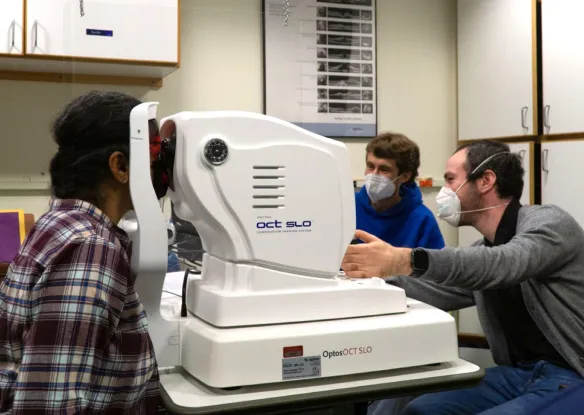We propose a multidisciplinary approach to effective spatiomotor rehabilitation in blindness and visual impairment. For those who have lost vision, the eye-hand coordination normally available for the manipulation of objects for everyday activities is unavailable and has to be replaced by information from other senses. It becomes crucial to activate cross-modal brain plasticity mechanisms for functional compensation of the visual loss in order to develop robust non-visual mental representations of space and objects. Such non-visual ‘maps’ are needed to guide spatiomotor coordination, reasoning, and decision-making. Our multidisciplinary approach to this problem lies uniquely at the intersection of the fields of blindness assessment, spatiomotor rehabilitation, and brain function, each a focus of one Specific Aim. The novel approach overcomes the shortcomings of traditional rehabilitation training, which can never cover all tasks that a person faces in life (and can be both tedious and expensive) — what has been missing is an integrative rehabilitation protocol to attack the core of the problem by addressing a wide spectrum of components for spatial cognition and hand-movement control in a single paradigm. To bridge this gap, the PI has developed an effective integrative rehabilitation tool, the Cognitive-Kinesthetic (C-K) training method to bridge the gap to wide-spectrum blind rehabilitation by employing an integral task (drawing) that can affect ‘at one stroke’ a wide vocabulary of core abilities that are building blocks for numerous everyday tasks. Our pilot testing shows C-K training to be a powerful instigator of multiple skills, such as generation of precise memory representations (mental maps), enhanced spatial cognition and improved spatiomotor coordination.
In Aim 1, we will comprehensively characterize the differential impact of life-history factors through a set of complementary forms of objective assessment of performance. In Aim 2, we will run the C-K rehabilitation training of precise (non-visual) spatiomotor coordination guided by tactile memory. After training, we will re-run all the assessments from Aim 1 to quantify the effectiveness of spatiomotor rehabilitation, its transfer to standardized measures for blind capabilities, and the effect of the independent life-history variables from Aim 1 on the effectiveness of the rehabilitation. To gain insights into the brain plasticity mechanisms that underlie the respective training effects, Aim 3 will compare whole-brain functional Magnetic Resonance Imaging (fMRI) before and after the C-K training to determine how the visual ‘eye-hand’ coordination is replaced by nonvisual spatial-memory/hand coordination. Understanding the behavioral and neural adaptation mechanisms underlying the rehabilitation of vision loss will meet the NEI strategic goal of providing a well-informed scientific approach to future rehabilitation. The comprehensive studies planned will generate a large-scale dataset of parallel measures of life factors, spatiomotor performance, and brain activity measures.
Public Health Relevance
Blind and visually impaired individuals often have a high degree of disability and poor participation in the workforce; a major reason for the problem is that they cannot rely on the visuomotor control that forms normal ‘eye-hand’ coordination. As the first multidisciplinary study of rehabilitation training for non-visual ‘spatial-memory/hand coordination’, this project aims to provide a conceptually novel and highly effective rehabilitation solution to this long-standing problem, and to thus maximize function, independence, quality of life, and employability in the blind and visually impaired population. In accordance with NEI strategic goals, this multidisciplinary project will promote the development of well-informed new rehabilitation approaches, and will also generate a large database of new knowledge on rehabilitation-driven spatiomotor improvement and cross-modal plasticity that we will make available online to benefit ‘cutting edge’ fields of mobile assistive technologies, vision restoration and prosthetics.







